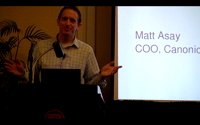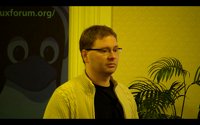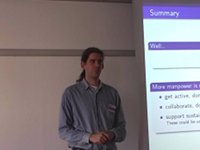Interesting features for embedded Linux system developers
 Linux 2.6.33 was out on Feb. 24, 2010, and to incite you to try this new kernel in your embedded Linux products, here are features you could be interested in.
Linux 2.6.33 was out on Feb. 24, 2010, and to incite you to try this new kernel in your embedded Linux products, here are features you could be interested in.
The first news is the availability of the LZO algorithm for kernel and initramfs compression. Linux 2.6.30 already introduced LZMA and BZIP2 compression options, which could significantly reduce the size of the kernel and initramfs images, but at the cost of much increased decompression time. LZO compression is a nice alternative. Though its compression rate is not as good as that of ZLIB (10 to 15% larger files), decompression time is much faster than with other algorithms. See our benchmarks. We reduced boot time by 200 ms on our at91 arm system, and the savings could even increase with bigger kernels.
This feature was implemented by my colleague Albin Tonnerre. It is currently available on x86 and arm (commit, commit, commit, commit), and according to Russell King, the arm maintainer, it should become the default compression option on this platform. This compressor can also be used on mips, thanks to Wu Zhangjin (commit).
For systems lacking RAM resources, a new useful feature is Compcache, which allows to swap application memory to a compressed cache in RAM. In practise, this technique increases the amount of RAM that applications can use. This could allow your embedded system or your netbook to run applications or environments it couldn’t execute before. This technique can also be a worthy alternative to on-disk swap in servers or desktops which do need a swap partition, as access performance is much improved. See this LWN.net article for details.
This new kernel also carries lots of improvements on embedded platforms, especially on the popular TI OMAP platform. In particular, we noticed early support to the IGEPv2 board, a very attractive platform based on the TI OMAP 3530 processor, much better than the Beagle Board for a very similar price. We have started to use it in customer projects, and we hope to contribute to its full support in the mainline kernel.
Another interesting feature of Linux 2.6.33 is the improvements in the capabilities of the perf tool. In particular, perf probe allows to insert Kprobes probes through the command line. Instead of SystemTap, which relied on kernel modules, perf probe now relies on a sysfs interface to pass probes to the kernel. This means that you no longer need a compiler and kernel headers to produce your probes. This made it difficult to port SystemTap to embedded platforms. The arm architecture doesn’t have performance counters in the mainline kernel yet (other architectures do), but patches are available. This carries the promise to be able to use probe tools like SystemTap at last on embedded architectures, all the more if SystemTap gets ported to this new infrastructure.
Other noticeable improvements in this release are the ability to mount ext3 and ext2 filesystems with just an ext4 driver, a lightweight RCU implementation, as well as the ability to change the default blinking cursor that is shown at boot time.
Unfortunately, each kernel release doesn’t only carry good news. Android patches got dropped from this release, because of a lack of interest from Google to maintain them. These are sad news and a threat for Android users who may end up without the ability to use newer kernel features and releases. Let’s hope that Google will once more realize the value of converging with the mainline Linux community. I hope that key contributors that this company employs (Andrew Morton in particular) will help to solve this issue.
As usual, this was just a selection. You will probably find many other interesting features on the Linux Changes page for Linux 2.6.33.


















 Being a member of the organization committee of the Embedded Linux Conference Europe, I get access to fresh news about this yearly conference. The call for presentations is now over and we have just announced
Being a member of the organization committee of the Embedded Linux Conference Europe, I get access to fresh news about this yearly conference. The call for presentations is now over and we have just announced  Bootlin has contributed to this release, by adding some support for the
Bootlin has contributed to this release, by adding some support for the  Looking for kernel and embedded Linux experts
Looking for kernel and embedded Linux experts Just a few weeks before the next edition of the
Just a few weeks before the next edition of the 












 The
The  The usual tracing-related talks, with Using the LTTng tracer for system-wide performance analysis and debugging by Mathieu Desnoyers and Ftrace – embedded edition, by Steven Rostedt. A talk on debugging Linux toolchain overview with advanced debugging and tracing features, by Dominique Toupin.
The usual tracing-related talks, with Using the LTTng tracer for system-wide performance analysis and debugging by Mathieu Desnoyers and Ftrace – embedded edition, by Steven Rostedt. A talk on debugging Linux toolchain overview with advanced debugging and tracing features, by Dominique Toupin. Linux 2.6.33 was out on Feb. 24, 2010, and to incite you to try this new kernel in your embedded Linux products, here are features you could be interested in.
Linux 2.6.33 was out on Feb. 24, 2010, and to incite you to try this new kernel in your embedded Linux products, here are features you could be interested in.